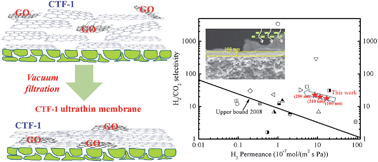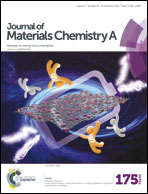A GO-assisted method for the preparation of ultrathin covalent organic framework membranes for gas separation†
Abstract
Energy-efficient and environmentally friendly separation processes are highly required in various industries, for which membrane-based separation technology is considered to be one of the most promising solutions. However, the development of membranes with efficient separation performances still remains a great challenge. Herein, a graphene oxide (GO)-assisted layer-by-layer restacking method was proposed to fabricate ultrathin covalent organic framework membranes for gas separation. The abundant functional groups in GO can improve the interactions, acting as “magnetic sheets”, to implement the up-down restacking of two dimensional (2D) covalent triazine-based framework-1 (CTF-1) nanosheets on the support, leading to the formation of continuous and dense ultrathin membranes with tunable thickness (100 nm, 210 nm, and 290 nm) by simple vacuum filtration of different amounts of dispersion liquid. Different numbers of nanosheets are restacked in these membranes, resulting in narrow interlayer passages that can exert an effect on the selective permeation of gas molecules with a tunable separation performance. As a demonstrative example, an efficient separation performance of H2 from CO2 was obtained with very high permeance for H2 (1.7 × 10−6 mol m−2 s−1 Pa−1) as well as a competitive selectivity. This method may also be applied to the development of ultrathin membranes from nanosheets of other materials.

- This article is part of the themed collection: 2016 Journal of Materials Chemistry A HOT Papers

 Please wait while we load your content...
Please wait while we load your content...